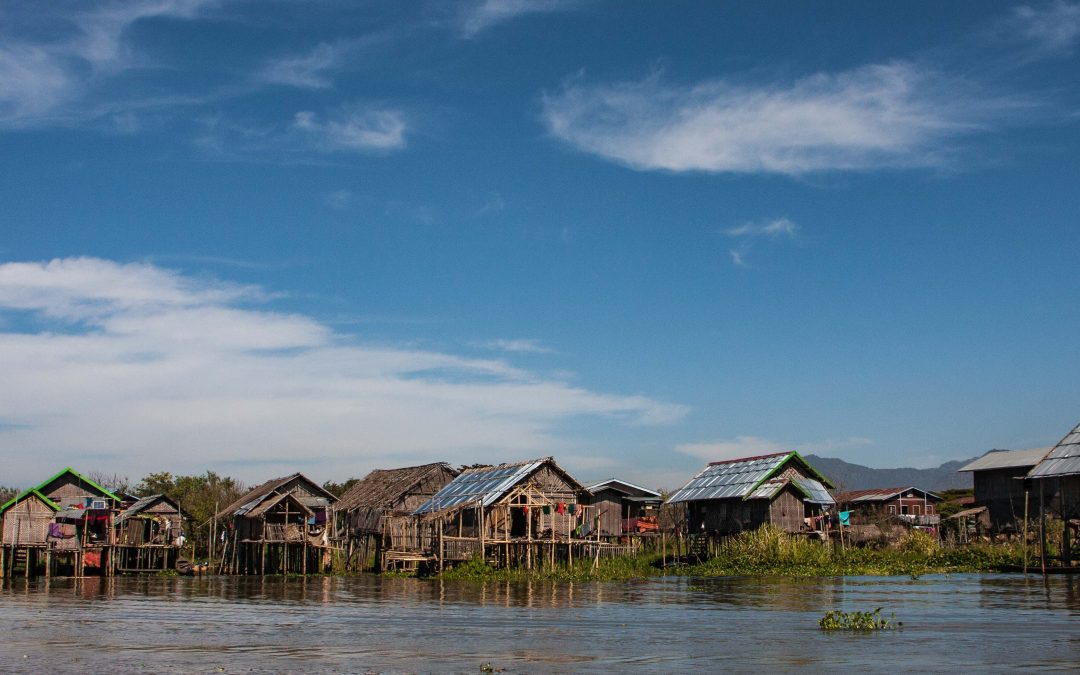Sometimes you will never know the true value of a moment until it becomes a memory.
Unknown
The village of In Sein is at the head of a long canal and on either side you get your first close up view of the the floating gardens. The floating gardens on Inle Lake cover a huge area. It’s worth taking a look at Google Earth so you can get an idea of the extent of them. The base on which the plants grow (I saw lots of tomato plants) are mats woven from vegetation and anchored to the floor of the lake so they don’t float away. One advantage of planting out on the lake is that the crop never needs watering.


Not only do the people garden on water, they also build there. Substantial houses made of wood and thatch rise on stilts many feet out of the water. Every home has a canoe or two sitting outside as this is the only way of communicating with the neighbours. There are often small pathways snaking alongside the canals and these are frequently bridged with bamboo poles. I am not sure I would want to scuttle across these bamboo bridges, especially balancing a load on my head, but they do look atmospheric.




The religious or spiritual in Myanmar is deeply embedded in everyday life. You can’t go far on Inle Lake without bumping into a pagoda or monastery or both. Two of the most visited are Phaung Daw U and Nga Hpe Kaung, which is commonly called Jumping Cat Monastery. Nga Hpe Kaung is surrounded by floating gardens.

Phaung Daw U is a very sacred pagoda as it is home to five very unusual Buddhas. It is a large pagoda, which seems circular in shape, with four tiered entrances, one in each direction.The alter sits in the middle and seems to consist of pairs of golden rocks perched on top of each other. These were originally Buddha statues that have assumed a very rotund and portly appearance because of the amount of gold leaf plastered on by the faithful.


Only men are permitted to do this: women must pay their respects from a distance. (I think of this as a cultural tradition rather than a religious one as I know the Buddha had serious female disciples). Every year, the rotund, golden Buddhas are taken out, washed and paraded in a very large ceremonial boat to each village around the lake. The ceremonial boat is accompanied by long boats propelled by a multitude of leg-rowers rowing in unison. It must be quite a sight.


Inle Lake is large and it takes a whole day to get around to the major tourist sites. You might think there are tourists round every corner but not so. There are shops (on stilts) where you can buy the usual tourist trinkets or watch weaving or eat lunch but most of the day is spent wandering along waterways amidst agricultural scenes that can transport you through centuries. In the distance you can spot a solitary leg-rowing fisherman, hurling his net into the water or slowly hauling it up. Beyond him, in the far distance, and through a curtain of haze, are the Shan hills that surround the lake. There is still a tradition of ‘slash and burn’ farming around the lake and these hills capture the smoke from the fires. Sometimes, it is maddening if you want a clear, focused documentary shot. But other times, atmosphere is king.



One of the last stops on the way back to Nyaungshwe is Nga Hpe Kaung also known as Jumping Cat Monastery. Story has it that the monks taught some cats to jump through hoops and will put on a show. I vaguely remember some young monks and cats from my first visit but it was a very perfunctory show. I haven’t seen the show or any cats since. In any case, the real reason to stop here is to marvel at the wooden monastery built on stilts in the middle of the nineteenth century.

It’s a beautiful old teak building with a huge meditation hall. The hall has a very large low platform on which a variety of beautiful Buddhas in various styles (Shan, Tibetan, Bagan and Inwa (Ava) sit or recline on wooden and mosaic pedestals. It’s late afternoon and the sun is low in the sky: sunbeams dance over the teak floor and provide precarious lighting for the Buddhas especially those partially hidden in recesses. Just as noon is the perfect time to see the ‘golden rock’ Buddhas at Phaung Daw U pagoda, late afternoon adds to the atmosphere that abounds at Nga Hpe Kaung monastery.



The trip back to NyaungShwe seems to be much shorter than the ourbound trip but provides enouh time to reflect on lives lived so differently from our own. The existance of peple tied so closely to the land and the water seems so timeless and the electronic world we inhabit seems so far away. Returning to Nyaungshwe from a sojourn on Inle Lake is an excursion halfway back to our modern world.

Privacy Policy



I loved the trip! Your story and pictures are wonderful. They bring back precious memories. I remember seeing really young kids rowing boats with confidence and agility in Inle Lake. Also, do you remember walking into a cigarette assembling ‘factory’ ?
Oh to go to Burma again!
Yes, that trip we did together in 1999 was wonderful. I had forgotten about the cigarettes until you mentioned it. Think maybe they were rolling cheroots.